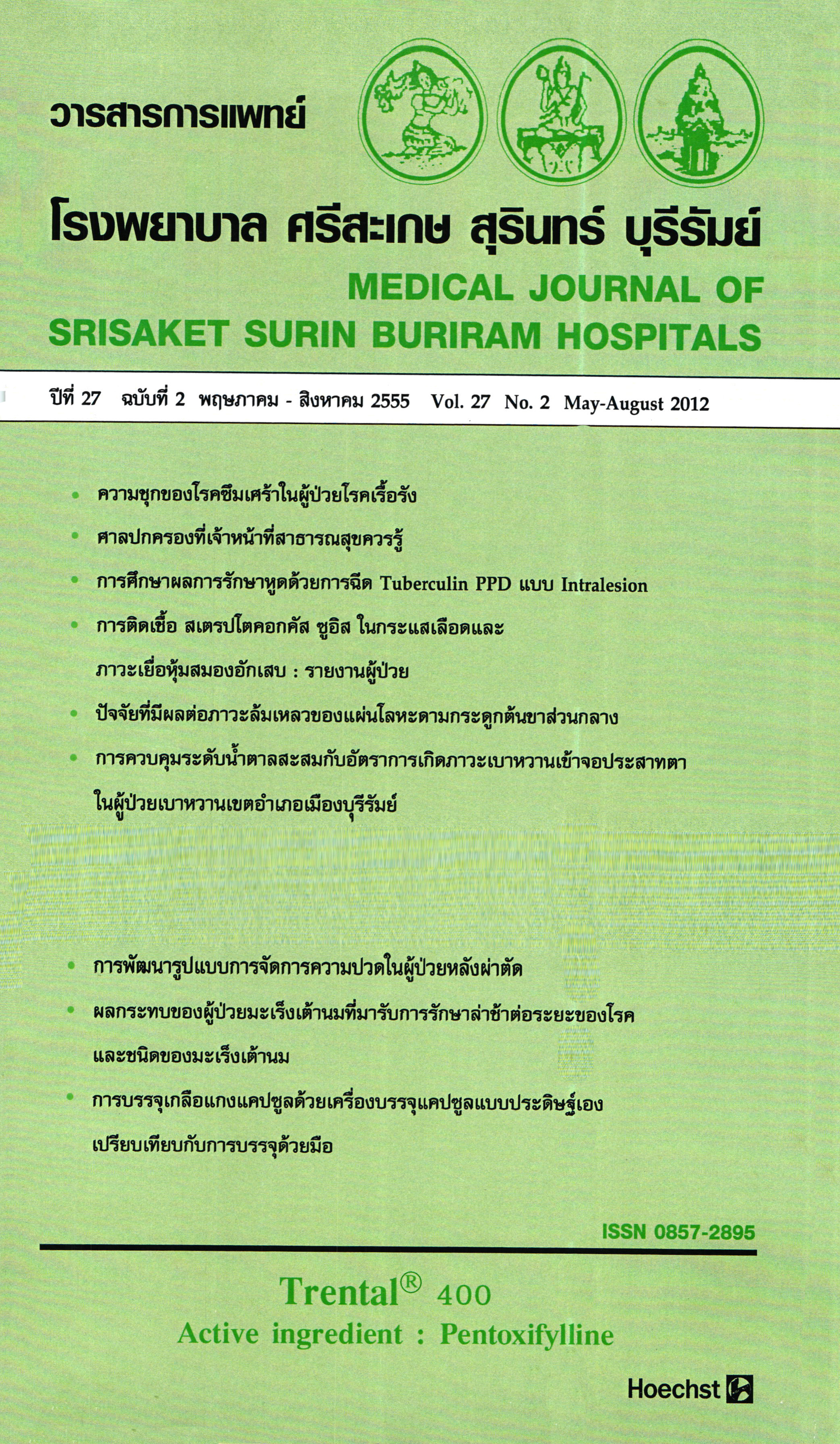การควบคุมระดับน้ำตาลสะสมกับอัตราการเกิดภาวะเบาหวานเข้าจอประสาทตาในผู้ป่วยเบาหวานเขตอำเภอเมืองบุรีรัมย์
Main Article Content
บทคัดย่อ
ความเป็นมา: ภาวะเบาหวานเข้าจอประสาทตาเป็นภาวะแทรกซ้อนที่พบบ่อยในผู้ป่วยโรคเบาหวาน และเป็นสาเหตุสำคัญที่ทำให้ตาบอดได้
วัตถุประสงค์: เพื่อเปรียบเทียบการเกิดภาวะเบาหวานเข้าจอประสาทตากับการควบคุมระดับนํ้าตาลสะสม ของผู้ป่วยเบาหวานในเขตอำเภอเมืองบุรีรัมย์
รูปแบบการศึกษา: การศึกษาเชิงวิเคราะห์แบบ case control study
กลุ่มเป้าหมาย: ผู้ป่วยเบาหวานในเขตอำเภอเมืองบุรีรัมย์ ที่ได้รับการตรวจคัดกรองภาวะเบาหวานเข้าจอ ประสาทตา โดยจักษุแพทย์ด้วยวิธี Indirect ophthalmoscope
วิธีการศึกษา: รวบรวมข้อมูลลักษณะทั่วไปของผู้ป่วย เพศ อายุ ระยะเวลาการเป็นเบาหวาน ผลการตรวจ จอประสาทตา น้ำหนัก ส่วนสูง ระดับความดันโลหิต ระดับน้ำตาลในพลาสมาก่อนอาหาร ระดับน้ำตาลสะสม และผลการตรวจทางห้องปฏิบัติการ วิเคราะห์ข้อมูลโดยโปรแกรม SPSS
ผลการศึกษา: ผู้ป่วยเบาหวานในเขตอำเภอเมืองบุรีรัมย์ที่มารับการตรวจคัดกรองภาวะเบาหวานเข้าจอ ประสาทตา ถูกคัดเลือกโดยการสุ่ม แบ่งเป็น 2 กลุ่ม ได้แก่ กลุ่มศึกษาเป็นผู้ป่วยเบาหวานที่ สามารถควบคุมระดับน้ำตาลสะสม (HbAlc ^ 6.5 %) จำนวน 150 คน และกลุ่มควบคุม เป็นผู้ป่วยเบาหวานที่ไม่สามารถควบคุมระดับน้ำตาลสะสม (HbAlc > 6.5 %) จำนวน 150 คน พบภาวะเบาหวานเข้าจอประสาทตาในกลุ่มผู้ป่วยเบาหวานที่สามารถควบคุมระดับ น้ำตาลสะสม (ร้อยละ 25.3) น้อยกว่ากลุ่มผู้ป่วยเบาหวานที่ไม่สามารถควบคุมระดับน้ำตาล สะสม (ร้อยละ 38.7) อย่างมีนัยสำคัญทางสถิติ (p-value = 0.01, OR = 1.9, 95% Cl 1.14 - 3.04)โดยปัจจัยเสี่ยงที่มีผลต่อการเกิดภาวะเบาหวานเข้าจอประสาทตาได้แก่ ระยะเวลาการป่วยเป็นเบาหวาน ระดับไขมัน triglyceride ระดับไขมัน HDL-C ระดับ creatinine ในเลือด ภาวะโปรตีนรั่วในปัสสาวะ ความดันโลหิตซิสโตลิกและค่าดัชนีมวล กายนั้น พบว่าไม่มีความแตกต่างกันอย่างมีนัยสำคัญทางสถิติระหว่างผู้ป่วยเบาหวานทั้งสอง กลุ่ม แต่ระดับน้ำตาลในพลาสมาก่อนอาหาร ระดับไขมัน cholesterol ระดับไขมัน LDL-C และความดันโลหิตไดแอสโตลิก พบว่ามีค่าสูงกว่าอย่างมีนัยสำคัญทางสถิติในกลุ่มที,ไม่ สามารถควบคุมระดับน้ำตาลสะสม สรุป : ผู้ป่วยเบาหวานที่สามารถควบคุมระดับน้ำตาลสะสมได้ พบการเกิดภาวะเบาหวานเข้าจอประสาทตาน้อยกว่าผู้ป่วยเบาหวานทีไม่สามารถควบคุมระดับน้ำตาลสะสม อย่างมีนัย สำคัญทางสถิติ
คำสำคัญ: ภาวะเบาหวานเข้าจอประสาทตา ปัจจัยเสี่ยง ระดับน้ำตาลสะสม
Article Details
References
2. Rawdaree P, Ngarmukos C, Deerochana- wong C, Suwanwalaikorn S, Chetthakul T, Krittiyawong S, et al. Thailand diabetes registry (TDR) project: clinical status and long term vascular complications in diabetic patients. J Med Assoc Thai 2006; 89 Suppl 1: Sl-9.
3. National Society to Prevent Blindness. Vision problems in the US: a statistical analysis. New York: National Society to Prevent Blindness; 1980:1-46.
4. Klein R, Klein BE, Moss SE, David MD, DeMets DL. The Wisconsin epidemiologic study of diabetic retinopathy. II. Prevalence and risk of diabetic retinopathy when age at diagnosis is less than 30 years. Arch Opthalmol 1984; 102: 520-6.
5. Klein R, Klein BE, Moss SE, Davis MD, DeMets DL. The Wisconsin epidemiologic study of diabetic retinopathy. III. Prevalence and risk of diabetic retinopathy when age of diagnosis is 30 or more years. Arch Ophthalmol 1984: 102:4: 527-32.
6. สำนักพัฒนาวิชาการแพทย์ กรมการแพทย์ กระทรวงสารารณสุข. แนวทางเวชปฏิบัติการ คัดกรองและทารคตดูแลรักษาจอประสาทตา ผิดปกติจากเบาหวานและแนวทางการ วินิจฉัย การป้องกันและรักษาโรคไตจากเบาหวาน. กรุงเทพมหานคร : ชุมนุมสหกรณ์การเกษตร แห่งประเทศไทย จำกัด, 2548.
7. สมาคมโรคเบาหวานแห่งประเทศไทย, สมาคมต่อมไร้ท่อแห่งประเทศไทย, กรมการแพทย์ กระทรวงสาธารณสุข, สำนักงานหลักประกันสุขภาพแห่งชาติ. แนวทางเวชปฏิบัติสำหรับ โรคเบาหวาน พ.ศ. 2554. กรุงเทพฯ : บริษัท ศรีเมืองการพิมพ์ จำกัด, 2554.
8. The Diabetes Control and Complications Trial Research Group. The effect of intensive treatment of diabetes on the development and progression of long-term complications in insulin- dependent diabetes mellftus. N Engl J Med 1993; 329: 977-86.
9. United kingdom Prospective Diabetes Study (UKPDS) Group. Intensive blood glucose control with sulphonylureas or insulin compared with conventional treatment and risk of complications in patients with type 2 diabetes (UKPDS 33). Lancet 1998;352:837-53.
10. United Kingdom Prospective Diabetes Study (UKPDS) Group: Effect of intensive blood glucose control with metformin on complications in overweight patients with type 2 diabetes (UKPDS 34). Lancet 1998;352:854-65.
11. Aiello LP, Cahill MT, Wong JS. Systemic consideration in the management of diabetic retinopathy. Am J Ophthalmol 2001; 132:760-6.
12. Burtis CA, Ashwood ER. Editors. Tietz textbook of clinical chemistry. 3rd Edition. Philadelphia. W.B Saunders. 2005.
13. สถาบันวิจัยและประเมินเทคโนโลยีทางการ แพทย์ กรมการแพทย์ กระทรวงสาธารณสุข.
รายงานวิจัยฉบับสมบูรณ์ ชุดโครงการวิจัยภาวะแทรกซ้อนทางคลินิกในผู้ป่วยโรคเบาหวาน ชนิดที่ 2 พ.ศ. 2554 (Clinical Complication in Type 2 Diabetic Patients). กรุงเทพฯ : สำนักงานกิจการโรงพิมพ์องค์การสงเคราะห์ ทหารผ่านศึก; 2554.
14. Yiling J, Cheng Edward W. Gregg, Linda S. Geiss et al. Association of A1C and Fasting Plasma Glucose level with diabetic retinopathy Prevalence in the U.S. Population. Diabetes Care 2009; 32:11: 2027-32.
15. Sukhum S, Roongthip S. Prevalence and Associated Factors of Diabetic Retinopathy in Chandrubeksa Hospital, Directorate of Medical Services, Royal Thai Air Force. J Med Assoc Thai 2012; 95 (Suppl. 4): 543-S49.
16. American association of clinical endocrinologists medical Guidelines for clinical practice for developing a diabetes mellitus comprehensive care plan. Endocr Pract 2011; 17(suppl 2):6-7.
17. Wilkinson CP, Ferris FL 3rd, Klein RE et al. Proposed international clinical diabetic retinopathy and diabetic macular edema disease severity scales. Ophthalmology 2003; 110:9:1677-82.
18. ขวัญเรือน วรเตชะ. ปัจจัยทางเมตะบอลิกที่มี ผลต่อภาวะจอประสาทตาเสื่อมของผู้ป่วยเบาหวานชนิดที่ 2 ในโรงพยาบาลเพชรบูรณ์. วารสาร วิจัยและพัฒนาระบบสุขภาพ 2011; 4:1:10-21.
19. สุนทราภรณ์ เตสมานนท์. ปัจจัยทีมีผลต่อภาวะเบาหวานเข้าจอประสาทตาในผู้ป่วยเบาหวานชนิดที่ 2. วารสารวิชาการโรงพยาบาล ศูนย์/โรงพยาบาลทั่วไป เขต 4, 2550; 10:5:
20. Chatziralli et al. Risk factors associated with diabetic retinopathy in patients with diabetes mellitus type 2. BMC Research Notes 2010, 3:153.
21. Dr. AL Ramadhan. Glycemic control (HbAlC) in patients with diabetic retinopathy. Thi-Qar Medical Journal 2011:5:3:103-8.
22. The Diabetes Control and Complications Trial Research Group. The relationship of glycemic exposure (HbAlc) to the risk of development and progression of retinopathy in the diabetes control and complications trial.Diabetesl995 Aug; 44:8: 968-83.
23. Sjolie AK, Stephenson J, Aldington S, Kohner E, Janka H, Stevens L, et al. Retinopathy and vision loss in insulin- dependent diabetes in Europe. The EURODIAB IDDM Complication study. Ophthalmology 1997; 104: 252-60.
24. สถาบันวิจัยและประเมินเทคโนโลยีทางการ แพทย์. แนวทางเวชปฏิบัติการปองกันดูแลรักษา ภาวะแทรกซ้อนจากโรคเบาหวาน(ตาไตเท้า). กรุงเทพฯ : บริษัทโอ-วิทย์(ประเทศไทย)จำกัด, 2553.
25. American Diabetes Association, standard of medical care in diabetes 2010. Diabetes Care 2010; 33 (Suppl. 1): Sll - S61.

